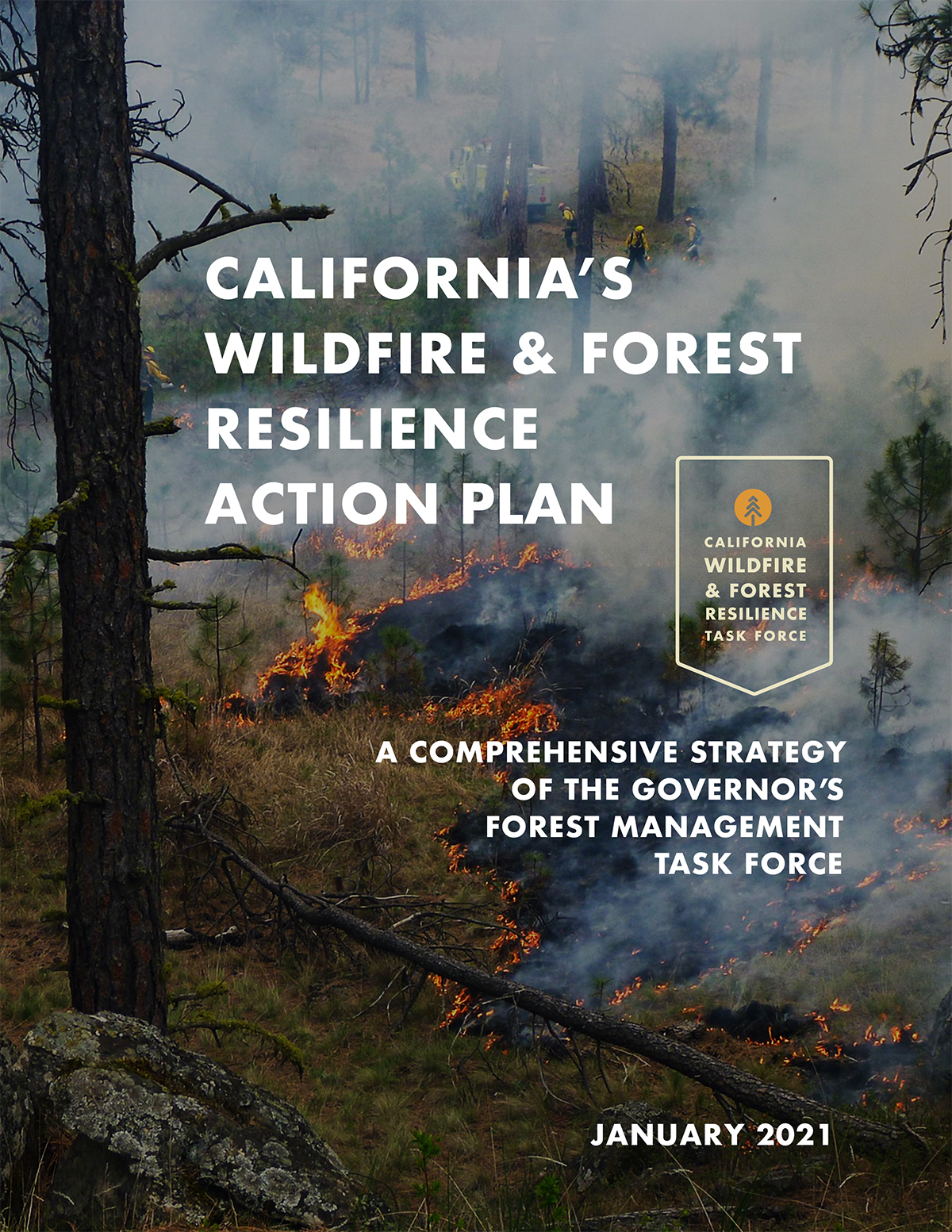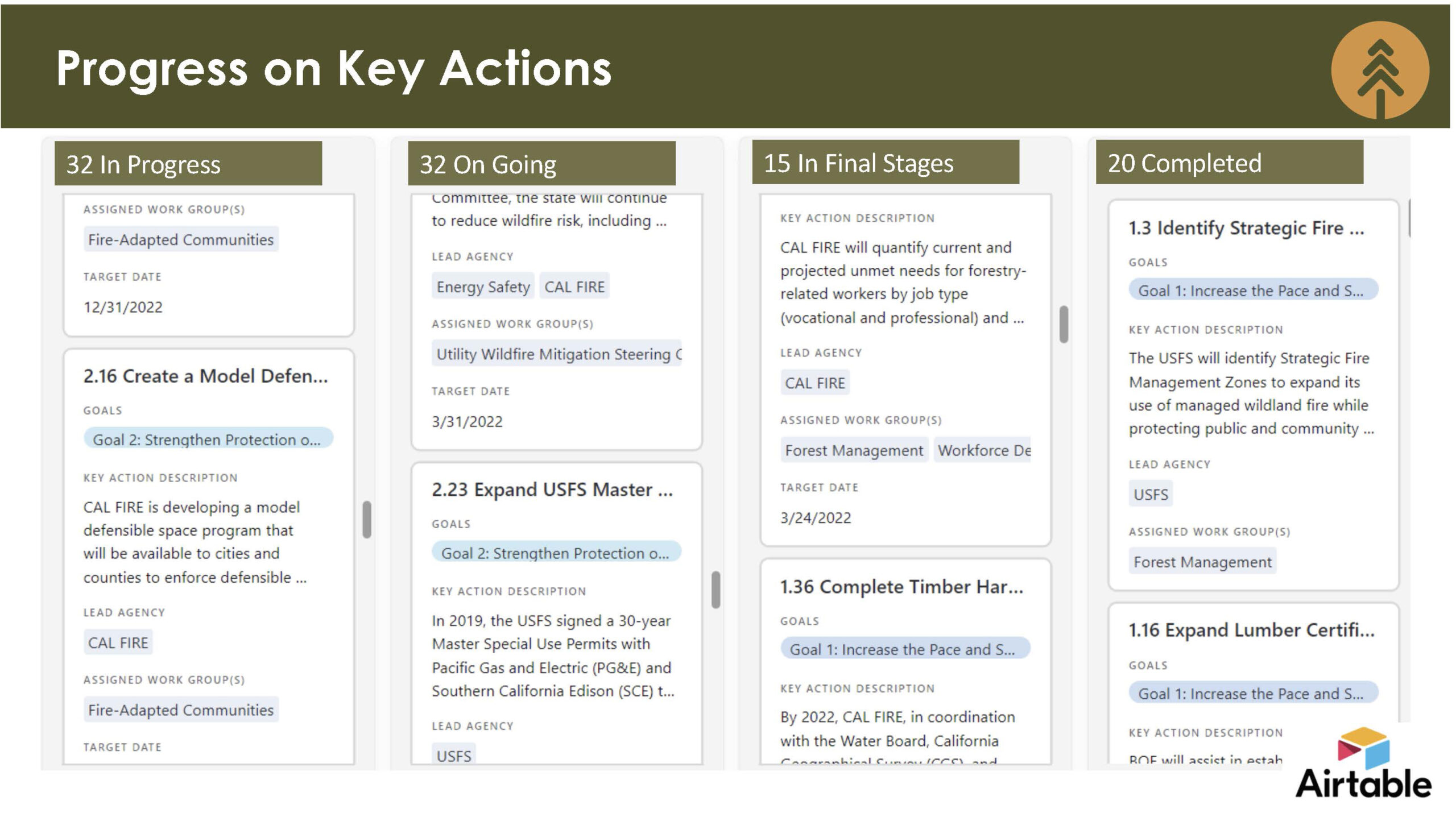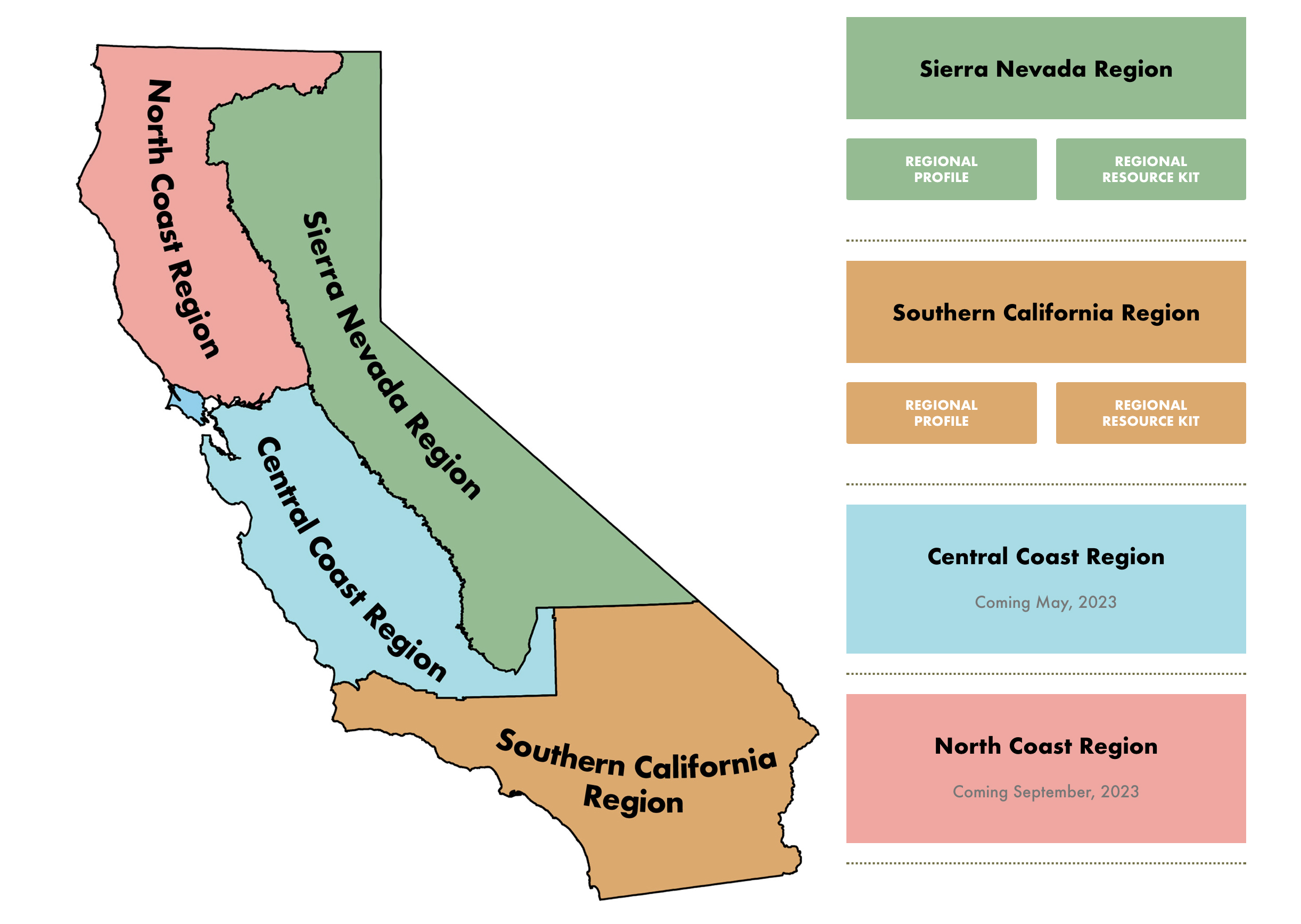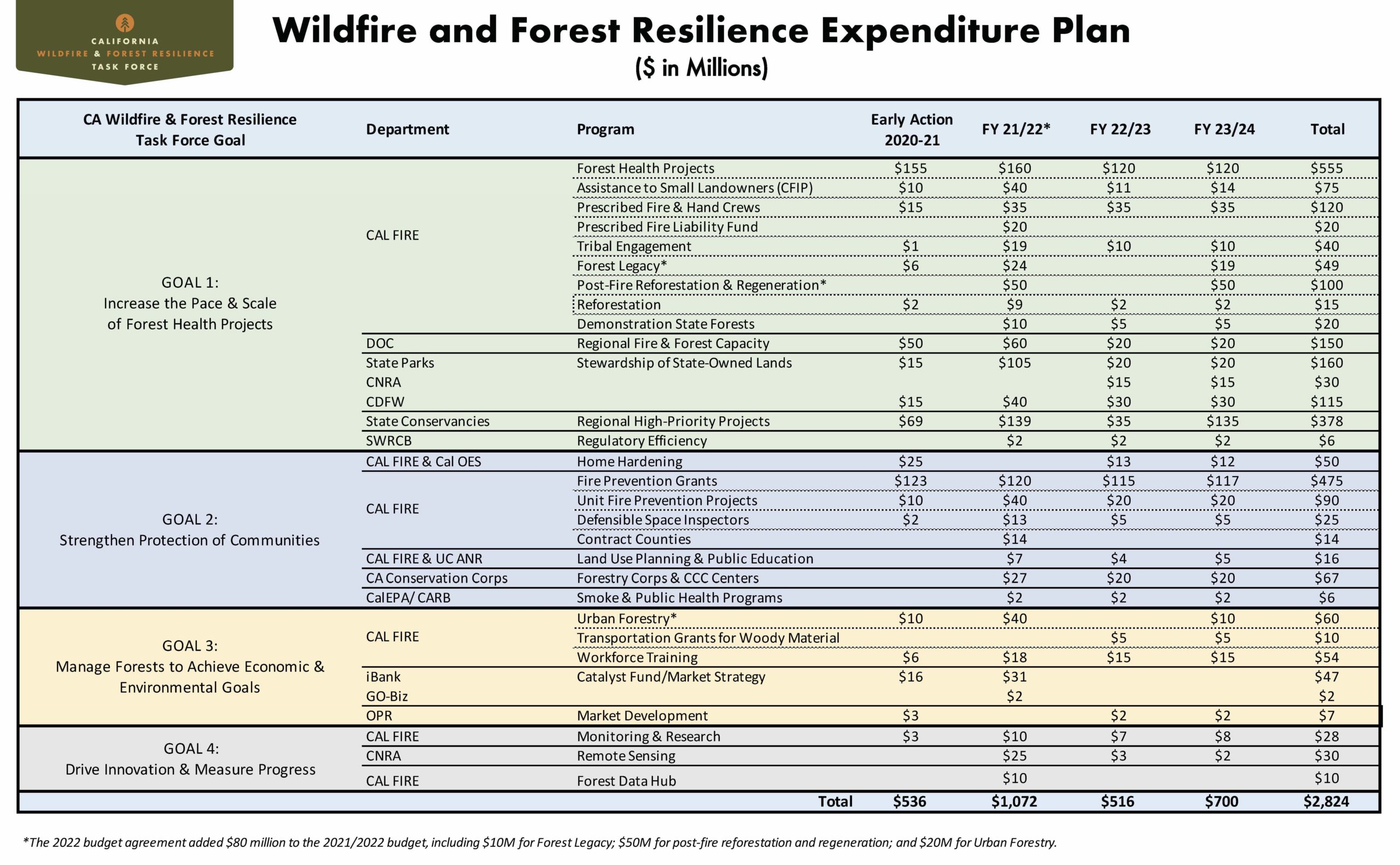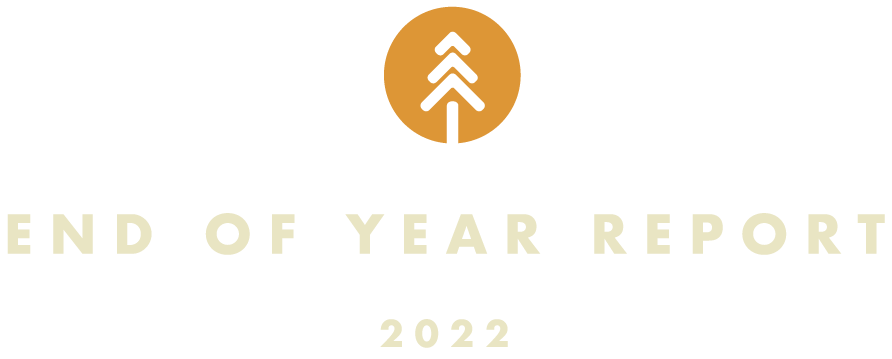
Introduction
The California Wildfire and Forest Resilience Task Force (Task Force) was established in 2021 to advance a holistic, integrated approach toward creating landscape and community resilience. The Task Force’s purpose is to deliver on the key commitments in the California Wildfire and Forest Resilience Action Plan (Action Plan) – a comprehensive framework for establishing healthy and resilient landscapes and communities that can withstand and adapt to wildfire, drought and a changing climate.
Senate Bill (SB) 456 requires the Task Force to submit a report annually on progress made in achieving the goals and key actions identified in the Action Plan.
To meet the requirements of SB 456, this report includes:
HIGHLIGHTS
This report covers progress made by the Task Force and its interagency partners from January 2021 through December of 2022. Highlights of this progress can be summarized under the four multi-jurisdictional goals of the Action Plan:
Goal 1: Increase The Pace and Scale of Forest Health Projects
- The Newsom Administration committed over $2.7 billion to forest and wildfire resilience. This included $1.5 billion in 2021, $630 million in 2022 and an anticipated $664 million in 2023.
- The Task Force and partners published California’s Strategic Plan for Expanding the Use of Beneficial Fire. Additional joint strategies will be published in early 2023.
- California Department of Forestry and Fire Protection (CAL FIRE) and the California Natural Resources Agency (CNRA) created and launched a new grant program supporting tribal wildfire resilience projects.
- The United States Forest Service (USFS) launched its 10-year plan, Confronting the Wildfire Crisis: A Strategy for Protecting Communities and Improving Resilience in America’s Forests.
- The USFS published Growing and Nurturing Resilient Forests: A Reforestation Strategy for the National Forest System – a focused effort to address current and future forest needs on the nation’s forests.
- The Department of Interior released a five-year Wildfire Risk Monitoring, Maintenance, and Treatment Plan to address wildfire risk.
Goal 2: Strengthen Protection of Communities
- CAL FIRE’s Defensible Space inspections increased by 41% since FY 19/20. More than 289,000 inspections were completed for FY 21/22.
- CAL FIRE updated the map of California’s Fire Hazard Severity Zones.
- The Office of Planning and Research (OPR) published two community wildfire planning resources: Wildland-Urban Interface (WUI) Planning Guide and an updated Fire Hazard Planning Technical Advisory.
- California Air Resources Board (CARB) released the California Smoke Spotter mobile app for wildfire alerts and smoke forecasts.
- Caltrans adopted a more comprehensive and aggressive fuels reduction strategy to reduce wildfire ignition probability and establish shaded fuel breaks along the travel routes it maintains.
- California’s Office of Energy Infrastructure Safety completed its evaluation and approval of the eight electrical corporations’ Wildfire Mitigation Plans.
- CAL FIRE published easy-to-use online application systems to request a Defensible Space Inspection and request Burn Permits or conduct post assessments.
Goal 3: Manage Landscapes to Achieve State Economic & Environmental Goals
- The Task Force and partners published California’s Joint Strategy for Sustainable Outdoor Recreation & Wildfire Resilience, which provides a roadmap for improved access to sustainable outdoor recreation, with a focus on areas wildfire impacts.
- CNRA set a vision to conserve 30% of California’s lands and 16% of its coastal waters in its strategy, Pathways to 30×30: Accelerating Conservation of California’s Nature.
- California Air Resources Board (CARB) released the 2022 Scoping Plan for Achieving Carbon Neutrality.
- Over 14,000 acres were added to CAL FIRE’s Demonstration State Forest System via donation from PG&E. These transactions come with enduring conservation easements that will ensure the lands are managed in perpetuity for research, forest restoration, and public recreation.
- CAL FIRE initiated a grant program to fund California business and workforce development projects that support healthy resilient forests.
- The Governor’s Office of Planning and Research, in coordination with the Board of Forestry launched a pilot project to study the aggregation of woody feedstock supplies to incentivize wood utilization industries.
Goal 4: Drive Innovation and Measure Progress
- The Task Force and its science advisors published a Regional Profile and created a Regional Resource Kit for the Sierra Nevada. The release of additional profiles and resource kits will coincide with regional meetings of the Task Force (Southern California – February 2023, Central Coast – May 2023, North Coast – October 2023).
- The Task Force, CNRA, and USFS, in partnership with Google.org developed Planscape, an open-source wildfire resilience planning tool for land managers.
- CAL FIRE launched an online viewer of CAL FIRE’s fuels reduction and fire prevention projects (CalMAPPER), which will serve as a model for other state agencies.
- CNRA, in partnership with the U.S. Geologic Survey collected new LiDAR and other remote sensing data across 31.5 million acres.
- The Task Force and its partners initiated the development of a Wildfire and Landscape Resilience Data Hub – a federated data system, integrating federal, tribal, state, local, and private reporting on forest management and carbon accounting programs.
- The Task Force and its partners created the framework for an Interagency Tracking System to provide data for planning, assessment and science; and to increase efficiencies in reporting.
I. Progress on Key Actions
The 2021 California Wildfire and Forest Resilience Action Plan comprises 99 Key Actions organized under the four multi-jurisdictional goals. Each of the Key Actions are assigned to a lead agency (or agencies) and a work group. Since April of 2021, the Task Force has tracked progress on the 99 Key Actions. Each quarter, the work groups update their progress on Key Actions and the Task Force summarizes these updates on its Progress on the Key Actions webpage.
Key Action Status as of January 1, 2023:
20 – Complete
32 – Remain On-Going Support Efforts
15 – Near Completion
32 – In Progress
II. Roadmap to Resilience
The Task Force has developed a three-tiered strategy for achieving landscape and community resilience throughout California. The elements of this strategy are:
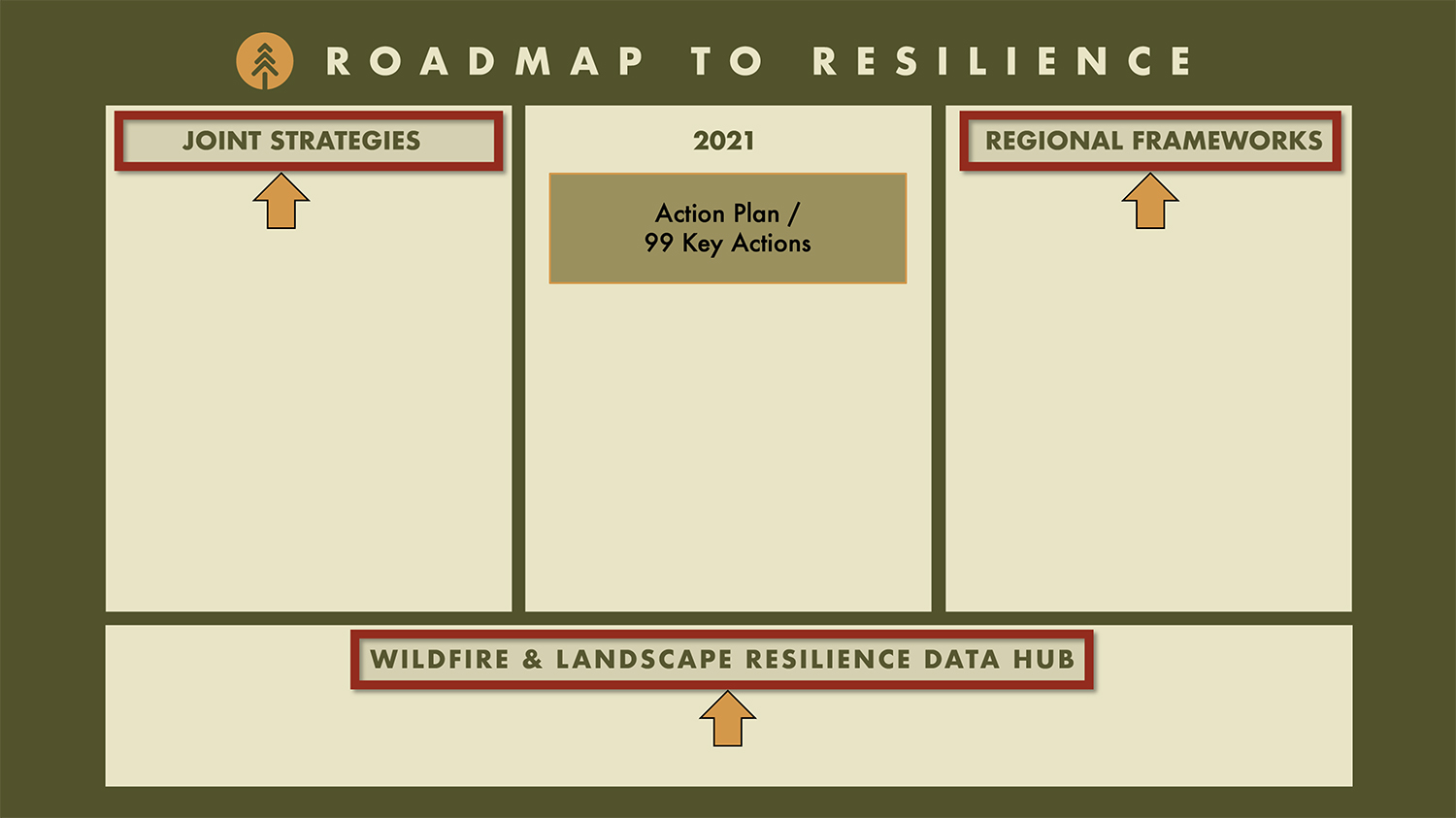
- Joint Strategies: The Task Force and its work groups are developing eight Joint Strategies that align and integrate state, federal, and tribal plans, mandates, and initiatives.
- Wildfire and Landscape Data Hub: The Task Force is aligning, developing, and distributing data and tools to assess conditions, plan projects, prioritize and report on acres treated, and measure effectiveness and progress toward meeting shared goals.
- Regional Frameworks: The Task Force is helping to build regional capacity by providing Regional Resource Kits and aligning resources to invest in high-priority projects.
A. Joint Strategies
Task Force work groups continued developing Joint Strategies in 2022 that set aggressive yet achievable targets for critical components of the Action Plan. The strategies highlight logistical barriers and policy issues and identify solutions for aligning efforts and achieving resilience. Upon completing a Joint Strategy, a work group will begin to implement their identified solutions.
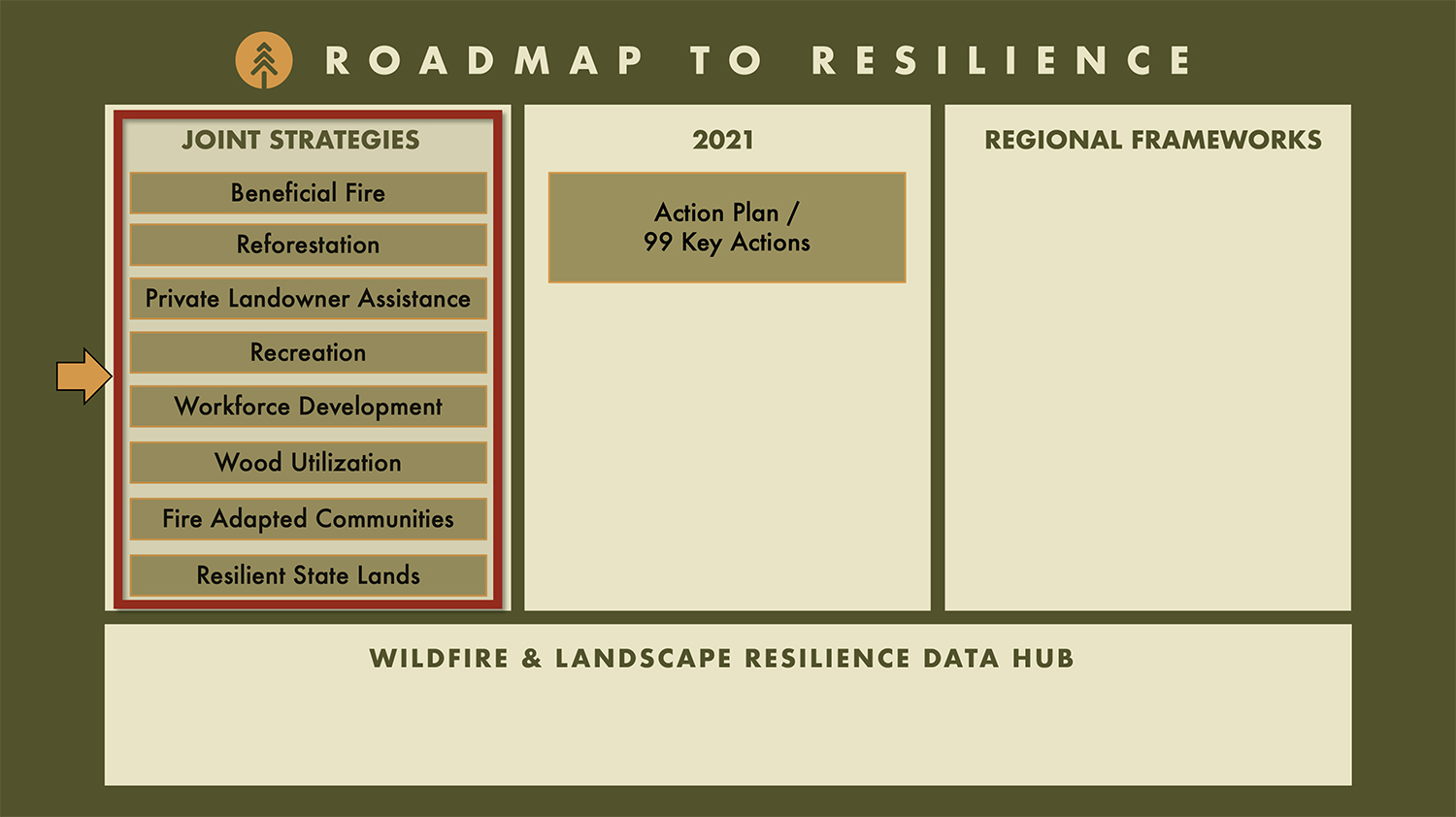
B. Wildfire and Landscape Resilience Data Hub
Key Action 4.3 of the Action Plan calls for the establishment of a Data Hub to serve as “a multi-institutional information clearinghouse with the goal of supporting, integrating, evaluating, and synthesizing ongoing reporting and monitoring efforts conducted by state and federal agencies, universities, and non-governmental organizations.”
The Task Force is developing the Wildfire and Landscape Resilience Data Hub (Data Hub) to serve as a centralized platform for integrating federal, tribal, state, local, and private reporting on forest management and carbon accounting programs and serve as a clearinghouse for new and emerging technologies and data platforms. Its function is to connect information sources, helping to standardize linkages to data while ensuring that people can access the right type of data, at the right time, to make critical decisions.
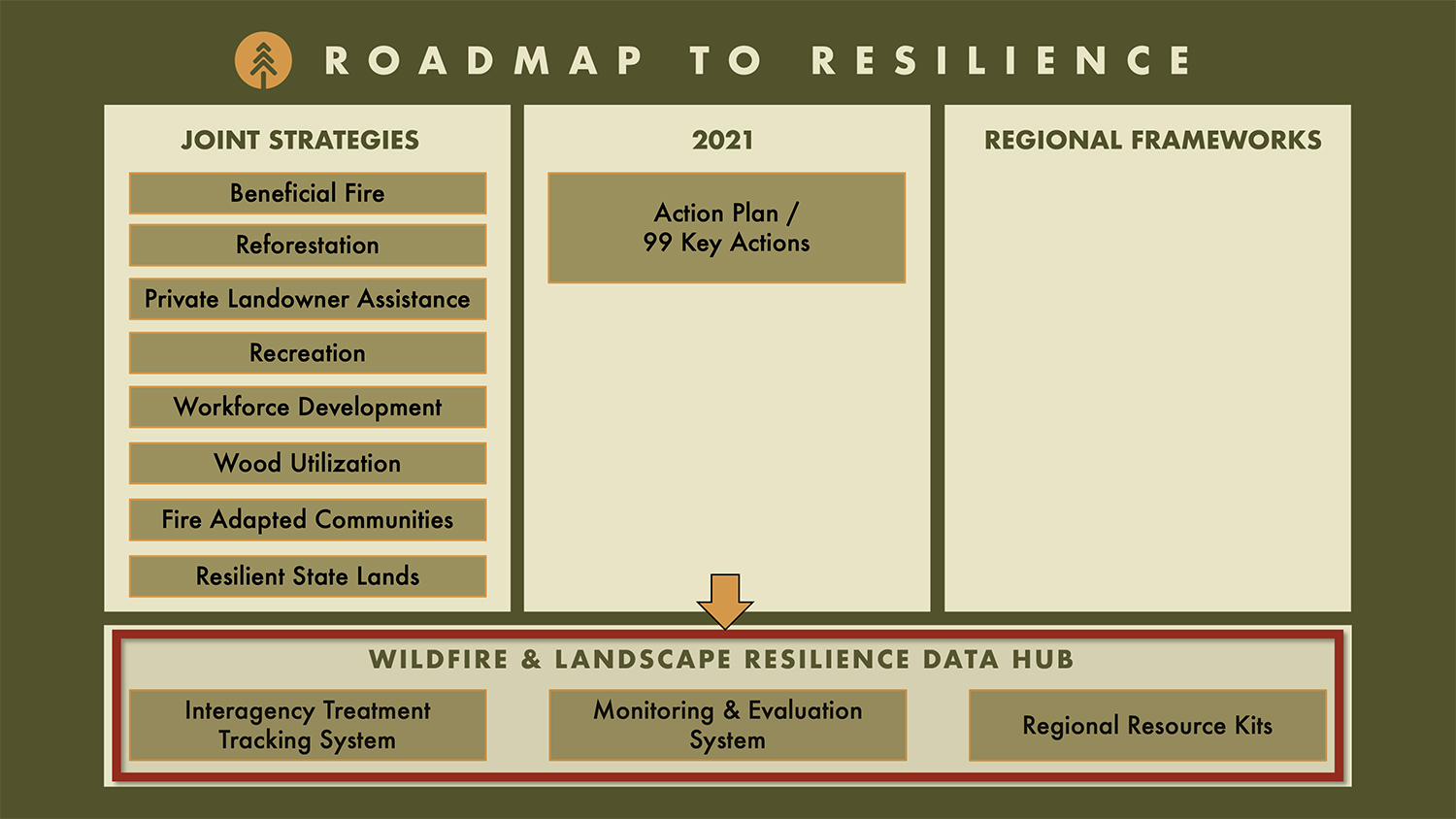
The Task Force’s Monitoring, Reporting and Assessment (MRA) Work Group and its partner the Climate and Wildfire Institute (CWI) have completed extensive stakeholder outreach and are currently developing a data needs assessment. Based on initial results, the MRA and CWI have proposed a scope of work for development of the Data Hub under a CAL FIRE Forest Health Research grant, with work beginning Spring 2023. Initial work will involve integrating multiple data streams from different sources into a single place, allowing users to interact with them as one. CWI will utilize an advisory committee to guide development decisions. When complete, the Data Hub will provide a stable data source for Task Force partners and work groups and will improve the public’s access to key data.
Task Force products currently under development that will be integrated into the Data Hub include:
1. Interagency Treatment Tracking System
Key Action 4.8 of the Action Plan calls for the development of consistent reporting tools. As such, the MRA Work Group is establishing an Interagency Treatment Tracking System for assembling federal, state, local and private data. The reporting tool is being developed to spatially track planned, active, and completed projects on forests, grassland and shrubland habitat statewide. The system will allow for spatially mapping footprint acres (the geographic area covered by the treatments) and the tabular reporting of activity acres, including the funding associated with that work. Categories of activities include:
-
-
- Mechanical and hand fuels reduction
- Timber harvest
- Tree planting
- Watershed & habitat improvement
- Beneficial fire
- Land Protection
-
2. Monitoring & Evaluation System
The Task Force is coordinating with CNRA and USFS on a monitoring and evaluation system to answer key questions on the effectiveness of treatments across California. The monitoring and evaluation system is integrating information from remote-sensing data, ground-level measurements, and other statewide efforts to assess the effectiveness and multiple benefits of projects. The system will also enable adaptive management under climate change to improve the effectiveness of future projects.
3. Regional Resource Kits
Resource Kits are a component of the Regional Frameworks as discussed below
C. Regional Frameworks
The Task Force recognizes that central to achieving the goals of the Action Plan is the need to mobilize regional approaches to landscape health and resilience.
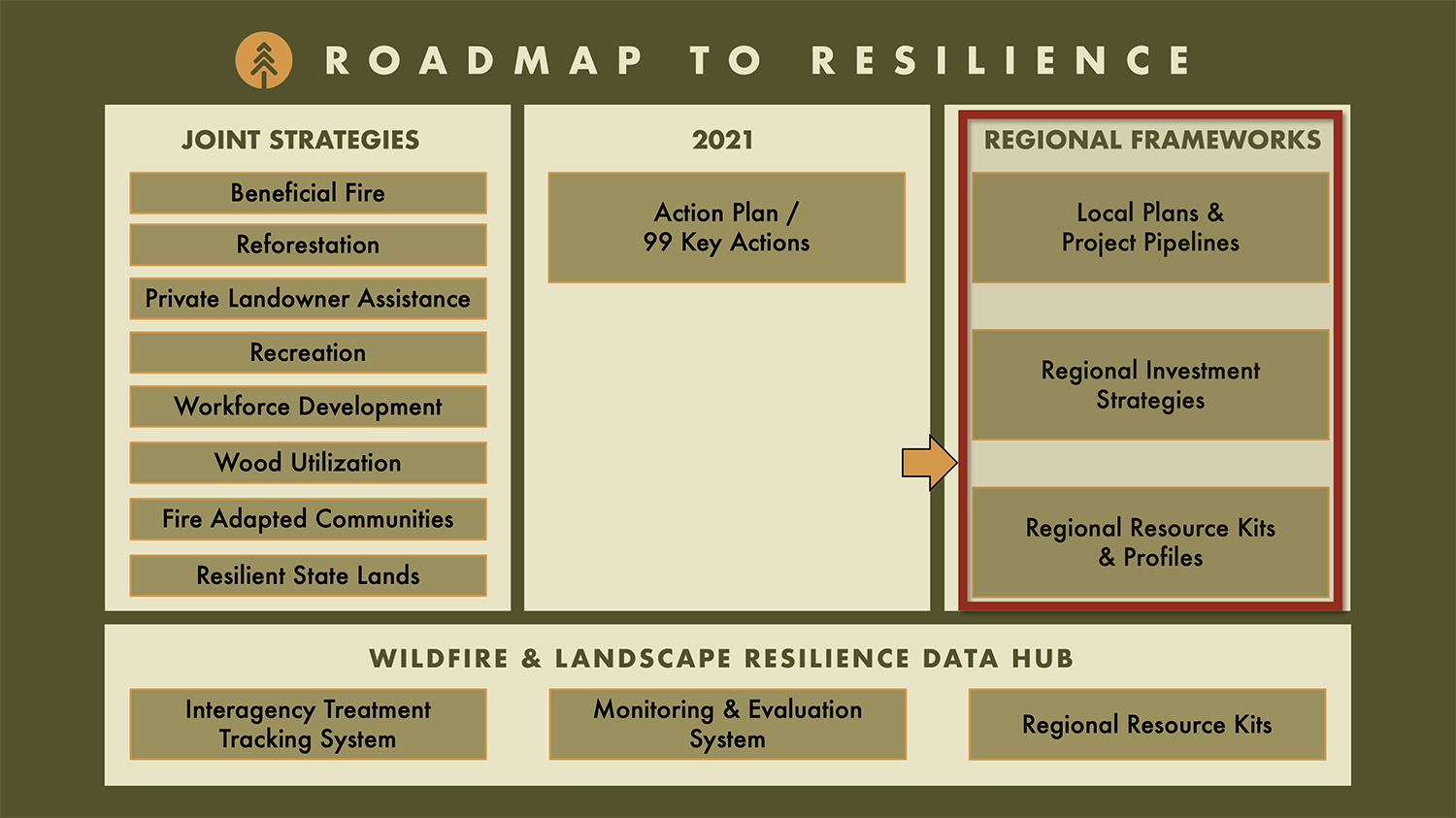
Regional Frameworks provide a structure for assessing landscape conditions; setting objectives; planning, funding and implementing projects; and measuring progress towards social-ecological resilience. The Regional Frameworks include the following key components:
1. Local Plans & Project Pipelines
The Department of Conservation’s (DOC) Regional Forest and Fire Capacity (RFFC) Program is a key component of the regional framework adopted by the Task Force. With support from the RFFC Program, local and regional leaders are developing Regional Priority Plans that identify and prioritize projects at the landscape or watershed-level to address forest health and wildfire risks within their region. Regional plans are guiding the development of a pipeline of projects which will feed combined federal, tribal state, and private regional investment strategies.
2. Regional Investment Strategies
The coordination of regional partners is providing a structure for federal, tribal, state, and private entities to coordinate their own efforts to fund landscape-scale, multi-benefit projects. CAL FIRE’s Forest Health Program first committed funding via a Regional Grant Pilot to collaborative land management partnerships and entities in the North Coast (May 2022) and the Sierra Nevada (September 2022). The Task Force will continue to work with federal and state partners and nonprofit foundations in 2023 to develop a joint investment strategy whereby regional partners administering grants at the regional and subregional levels deliver forest health, landscape restoration and wildfire and community resilience projects on the ground.
3. Regional Profiles
The Science Advisory Panel of the Task Force is developing a series of Regional Profiles to summarize the social and ecological context relating to community and ecosystem resilience to wildfire in each of the state’s four diverse regions. The content of each Regional Profile is informed by the best available scientific information, as well as the experience and perspectives of diverse stakeholders from each region. Each Regional Profile includes stakeholder input gathered via an anonymous survey about priority areas of investment for achieving resilience, as well as more focused interviews with regional experts and leaders about key issues, barriers, and opportunities for increasing resilience to wildfire. A Regional Profile has been completed for the Sierra Nevada with Southern California, Central Coast, and North Coast region profiles expected for February, May, and September 2023 respectively.
4. Regional Resource Kits:
An interagency team of scientists is developing the Regional Resource Kits to help regional partners plan, prioritize, and monitor projects.

Each Regional Resource Kit provides:
- Pillars of Resilience – The set of 10 pillars describe desired landscape outcomes that encompass the suite of social and ecological benefits provided by resilient systems across fire-prone landscapes. Each RRK contains statewide and regional data and metrics that combine into the Pillars framework. The result is a set of California Pillars of Resilience measures that are driven by regionally-specific needs and risks.
- Metrics – a core database of management-relevant metrics that have been vetted by federal, state, and academic scientists. Each Resource Kit contains unique metrics tiered to the Pillars of Resilience and driven by regionally specific needs and risks.
- Assessments/Priorities – a suite of data and mapping tools that offer spatially explicit assessments of current conditions for key resources.
- Decision-Support – a set of tools to help land managers evaluate large amounts of data to consider potential management options. Such tools are often used to compare current with future or desired conditions or examine tradeoffs among alternative land management actions.
- Decision Support Guide – an online guide to help land managers better understand the tools available to them to help make the critical decisions required to keep their lands healthy and resilient. The Science Advisory Panel, in collaboration with U.S. Forest Service Region 5 and Pacific Southwest Research Station, created the guide.
- Planscape –a free, open-source, web-based tool for regional planners to plan, prioritize, and coordinate resilience treatments across their landscape of interest. The Task Force is developing mechanisms to continue hosting, maintaining, and supporting the tool for the long-term, and to ensure consistency and integration with other Task Force products. CNRA, USFS, and the foundation arm of Google (Google.org) are jointly developing Planscape.
- Project Inventories/Tracking System – a set of regionally specific data and tools derived from the statewide Interagency Treatment Tracking System discussed above in section B: Wildfire and Landscape Resilience Data Hub.
- Monitoring/Evaluation – a set of regionally specific data and tools derived from the state Monitoring and Evaluation System discussed above in Section B: Wildfire and Landscape Resilience Data Hub.
Regional Resource Kits have been completed for the Sierra Nevada and Southern California regions with Central Coast and North Coast region profiles expected for May and September 2023 respectively. The Task Force will continue augment, update, and maintain the Resource Kits over time, and will integrate the Kits into the Forest Data Hub.
III. 2023 Million Acre Scenarios
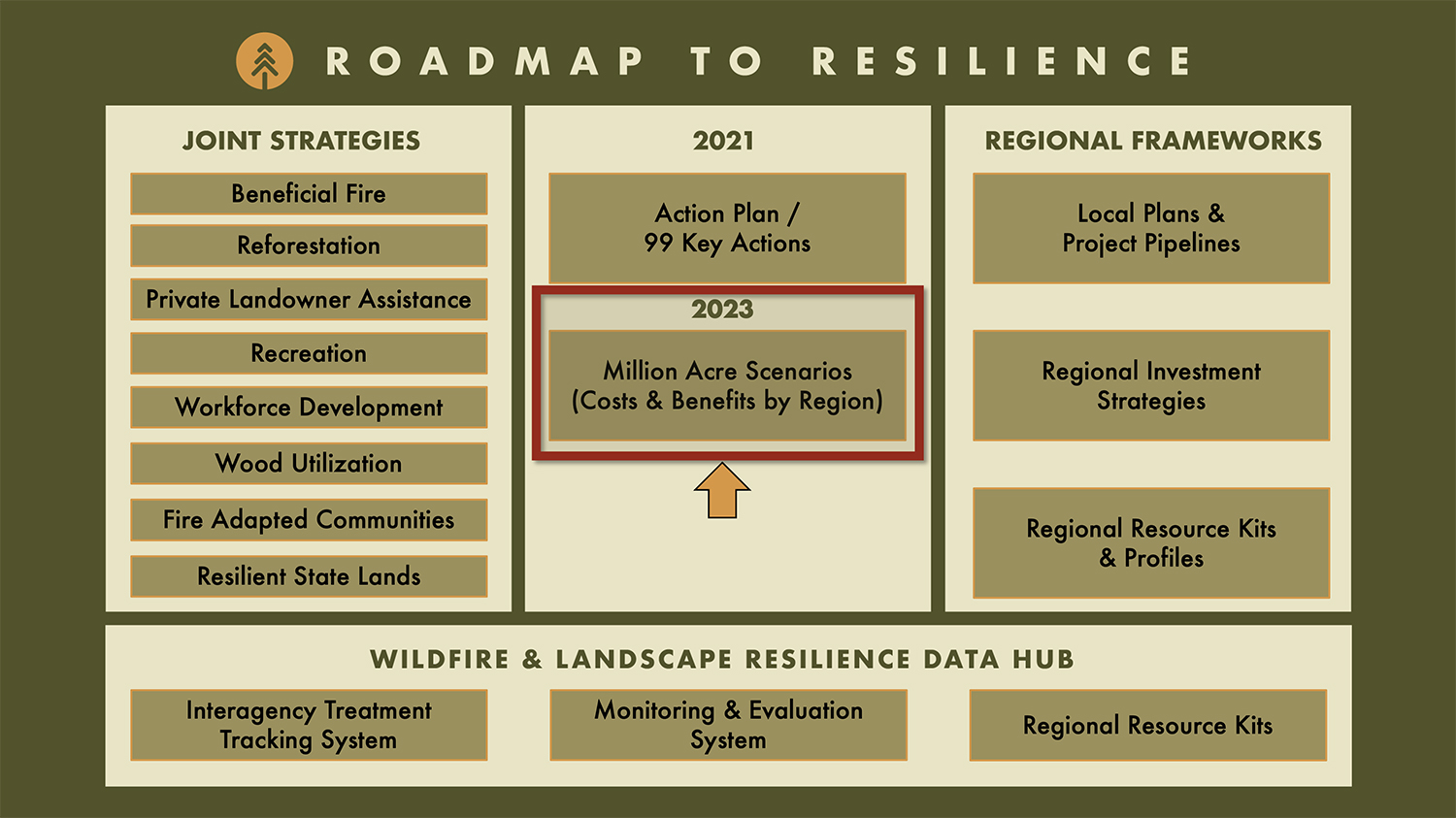
State and federal partners have committed to restoring one-million acres annually by 2025. In 2023, the Task Force will begin evaluating alternative pathways to achieve the target by modeling and analyzing multiple treatment scenarios. The scenarios will consist of four components:
1. A set of treatment scenarios by region with varying locations, amounts, intensities, and types of treatments.
2. An evaluation of the costs, benefits, and trade-offs between the modeled scenarios by region.
3. A set of recommendations drawing from treatment scenarios and derived from a common framework of metrics and assessments to align state, federal, and local investments in state and regionally driven forest and wildland health programs across regions.
4. The evaluation of costs and benefits, and the recommendations to align programs will be used to identify existing policy changes that will be required to meet the one-million-acre treatment target.
This effort will focus on four of the ten Pillars of Resilience (as defined above) to showcase the tradeoffs of different scenarios on several key statewide priorities: fire-adapted communities, carbon sequestration, water security, and biodiversity conservation.
IV. Action Plan Update
The Joint Strategies, Data Hub, Regional Frameworks and Million-Acre Scenarios will be integrated into an update of the California Wildfire and Forest Resilience Action Plan, planned for Spring 2024.
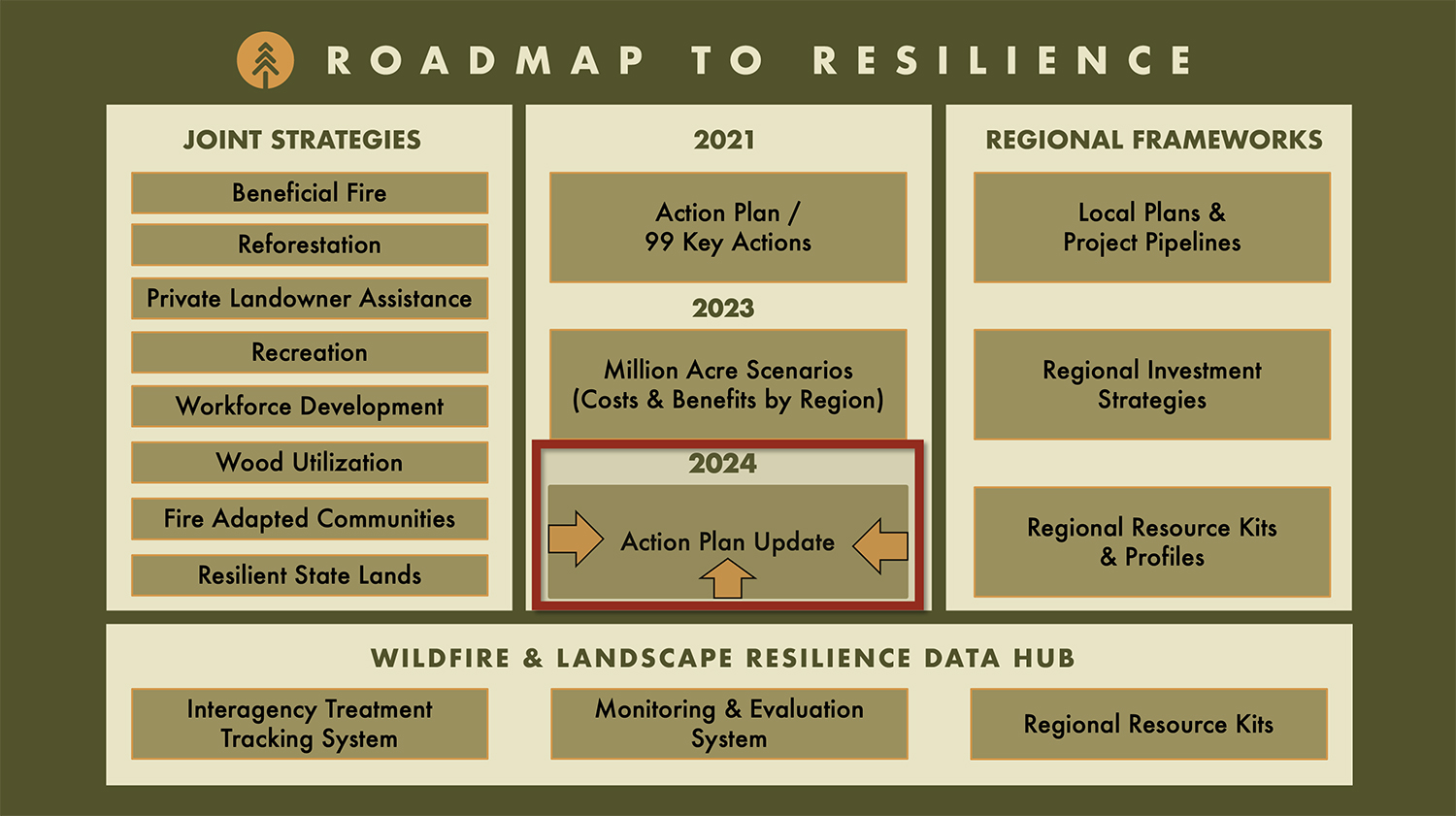
The Action Plan update will lay out the charge for the next five years and the steps necessary to increase the pace and scale of landscape management and wildfire resilience efforts beyond 2024. The update will include:
- Updated Goals and Key Actions that integrate the strategic solutions identified in Joint Strategies, Regional Priority Plans, and Regional Investment Strategies.
- Processes for aligning and integrating Task Force data activities with initiatives and mandates that overlap with the update, including the USFS 10-Year Wildfire Crisis Strategy, California’s 5th Climate Change Assessment, Climate Change Scoping Plan, Natural and Working Lands Climate Smart Strategy, Pathways to 30×30.
V. Wildfire & Forest Resilience Expenditure Plan
The Task Force has developed a Wildfire and Forest Resilience Expenditure Plan that links Action Plan deliverables with the state’s proposed and enacted budget allocations. The Expenditure Plan was last updated to reflect AB179, the Budget Act of 2022, which provided more than $1.3 billion over the next two years to accelerate forest health and wildfire resilience projects throughout the state. With these investments, the Newsom Administration has committed more than $2.7 billion to the Action Plan.
EXPENDITURES:
State Highlights:
The California Natural Resources Agency compiled a report on California’s Wildfire Resilience Investments through March 1, 2023, a program-by-program description of the 40 programs these investments fund, examples of recent impacts from each of those programs, and an interactive table that shows the status, location and description of each of the nearly 1,200 projects already completed or underway (shown below).
Federal Highlights:
-
-
- The United States Forest Service (USFS) allocated $19 million for State and Private Forestry to support recovery of non-industrial private forest landowners under the Extending Government Funding and Delivering Emergency Assistance Act (Public Law 117–43).
- In support of the USFS’ 10-year strategy targeted investments of $28.6 million from the Bipartisan Infrastructure Law were made in the Stanislaus and Tahoe national forest. An additional $52.1 million was committed over the next three years, for a total of $80.7 million.
- The USFS awarded over $7.6 million in California-based wood innovation projects to improve markets for biomass and low-value wood.
- U.S. Economic Development Administration awarded $21.5 million to the Foundation for California Community Colleges for workforce training in forest health and fire safety.
-
VI. Continued Communications
The Task Force uses multiple communication channels to ensure timely and transparent communications to interested parties. These channels include:
-
-
- Bi-Monthly Meetings: The Task Force meets bi-monthly (live and livestreamed options), with quarterly convenings hosted in each of the four regions of the state. The meetings are recorded and archived.
- Task Force Website: The Task Force hosts a full-service website with the latest news and updates; meeting agendas and recordings of past meetings; Task Force organization and contacts; Airtable updates; Working group assignments; and press releases and publications.
- Monthly Update to the Governor: The Task Force assembles a monthly newsletter comprised of briefs of the latest state and federal updates; Task Force news; pending legislation; and science and press publications. The “Governor’s Monthly Update” is delivered via e-Newsletter to a electronic mailing list of over 1,100 subscribers.
- Videos: The Task Force hosts videos on YouTube (@cawildfireforestresilience6079) of archived Task Force meetings, Work Group presentations and partner interviews.
- Social Media: Regular posts on Task Force and partner accomplishments are delivered across the following outlets:
-
-
-
-
- Twitter: @CAwildfireTF
- LinkedIn: CA Wildfire & Forest Resilience Task Force
- Instagram: wildfiretaskforce
- Facebook: CA Wildfire and Forest Resilience Task Force
-
-

